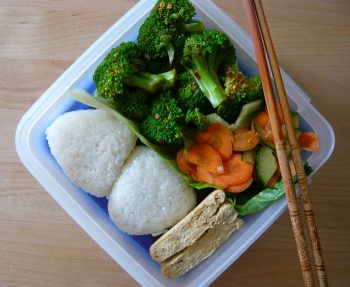How Bento Became a Taiwanese Staple Posted by Ayana on Jun 12, 2017 in Uncategorized
In my post last month I discussed a traditional Chinese item that originally came from the Japanese culture – the Lucky Cat. The Lucky Cat was so well assimilated into the Chinese life, that it doesn’t feel imported at all. So is the item we are about to explore today – the Bento, or in its Chinese name – 便当 (Biàndang). As with the lucky cat, the 便当originated in Japan but became an integral part of the Taiwanese culture.
便当主要通行于亚洲以稻米作为主食的地区 (Zhǔyào tōngxíng yú yàzhōu yǐ dàomǐ zuòwéi zhǔshí dì dìqū) = the便当is in general use mainly in Asia, in regions where rice is the staple food. Bento originated in Japan and is very common in the Japanese kitchen. It became very popular in Taiwan; and entered other Asian countries as well, such as Korea, India, Philippines, etc.
便当是盒装餐食 (Biàndang shì hé zhuāng cān shí) = 便当 is a meal packed in a box. It can be a现成的便当 (xiànchéng de biàndang) = a ready-made box you buy at supermarkets or convenience stores. Or it can be a box you buy at special restaurants called自助餐店 (zìzhù cān diàn) = buffet restaurants. In which you can选取自己喜欢的菜 (xuǎnqǔ zìjǐ xǐhuan de cài) = choose your favorite dishes.
The word便当is an adjective literally meaning ‟convenient”, ‟handy”, or ‟easy”. And so is the purpose of this lunch box. 便当is a convenient way to eat outside, 但是便当可以是家庭自制 (dànshì Biàndang kěyǐ shì jiātíng zìzhì) = but 便当can also be a homemade food. It can be a box a mother cooked for her kids to take to school, or a box she prepared for herself to take it to work. It’s a homemade food, but 非家里开伙 (fēi jiālǐ kāihuǒ) = not usually eaten at home. 不少学生把家里制作好的便当带到学校去 (Bù shǎo xuéshēng bǎ jiālǐ zhìzuò hǎo de biàndang dài dào xuéxiào qù) = many students bring their homemade lunch box to school.
The containers’ shapes of the 便当are different: some are rectangular, some are elliptic, some divided to several partitions, some are one part box. But most of them consist of the same food. 便当通常用于午餐与晚餐 (biàndang tōngcháng yòng yú wǔcān yǔ wǎncān) = 便当is normally for lunch or dinner. It includes: rice/noodles + fish/meat – or tofu if it is a vegetarian box + cooked vegetables.
To see more examples of 便当 watch this video:
Next time you visit Taiwan try one of those many 便当. Bon appetit!
Text vocabulary
便当 Biàndang = lunch (or dinner) box
亚洲 Yàzhōu = Asia
主食 Zhǔshí = staple food
盒子 Hézi = box, case
盒装 Hé zhuāng = packed in a box
现成 Xiànchéng = ready-made
自助餐 Zìzhù cān = self service buffet
开伙 Kāihuǒ = to provide food
带 Dài = to take
午餐 Wǔcān = lunch
晚餐 Wǎncān = dinner

Build vocabulary, practice pronunciation, and more with Transparent Language Online. Available anytime, anywhere, on any device.





Leave a comment: